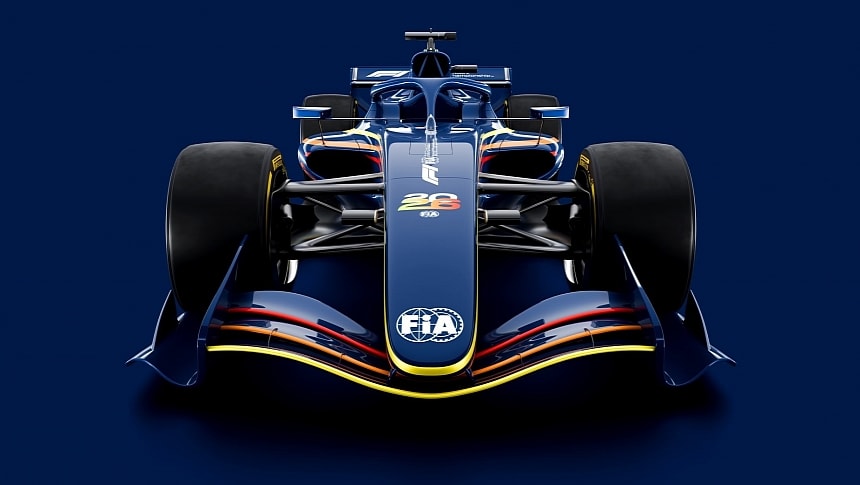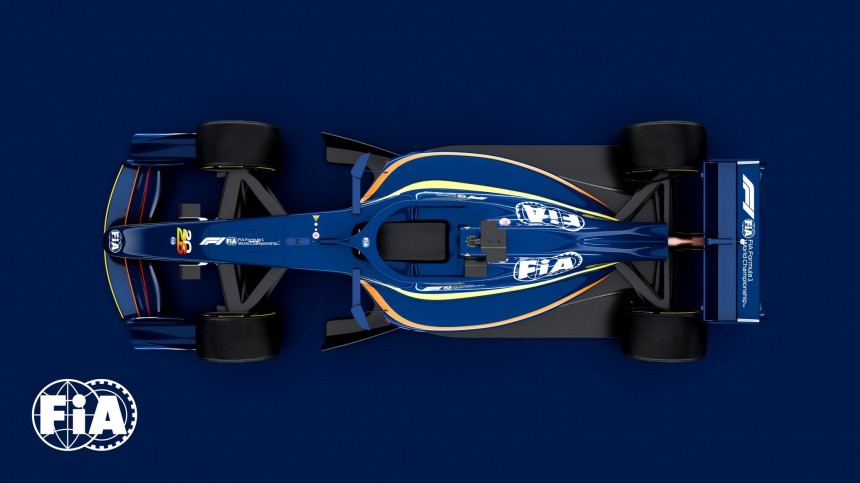The FIA has unveiled the 2026 Formula 1 regulations, along with a concept car that serves as the blueprint for all teams on the grid. Despite the switch to 100% sustainable fuels, the FIA couldn't make a case for the return of the 3.0-liter V10 we all know and love from the 1995 to 2005 seasons.
Having mentioned engine regulations, the 1.6-liter turbo V6 hybrid power unit will be simplified for 2026, with the main difference being the removal of the MGU-H. The regulations also reveal that F1 will put a greater emphasis on electric power. More specifically, the electric side of the powertrain is almost 300% punchier than before, going from 120 kilowatts to 350 kilowatts (476 ps or 469 hp).
The redesigned six-cylinder engine, on the other hand, will be turned down from the current 560 kW (761 metric or 751 mechanical ponies) to 400 kW (544 ps or 536 hp). Drivers will be able to recuperate double the energy during the braking phase, as in 8.5 MJ per lap. The FIA has confirmed six engine suppliers for 2026, those being Red Bull Powertrains, Ferrari, Mercedes, Renault in the form of Alpine, Honda, and the VW Group's Audi.
It's quite sad that Andretti's F1 bid with Cadillac hasn't come to fruition, but looking at the bigger picture, anything can happen in the following one and a half years. Turning our attention back to the 2026 regs, the car is 30 kilograms (66 pounds) lighter, bringing the minimum weight from the current 798 to 768 kilograms (1,693 pounds).
Instead of the drag reduction system, drives are presented with something called manual override. Think of it this way: the leading car's energy deployment tapers off after 290 kilometers per hour (180 miles per hour) and reaches zero at 355 kilometers per hour (221 miles per hour), whereas the following car benefits from MGU-K Override. Said manual override system provides 350 kW of electrical energy at up to 337 kilometers per hour (209 miles per hour). Similar to DRS, the new system can be engaged by the driver if the following vehicle is within a second of the one in front.
To enable better racing, the FIA has also decided to cut 200 millimeters from the wheelbase and 100 millimeters from the width of the car, thus brining them to 3,400 and 1,900 millimeters, respectively. If you prefer inches, make that 133.8 and 75.0. Although the 18-inch wheels will be retained, the width of the Pirelli tires will be reduced by 25 mm (1.0 in) up front and 30 mm (1.2 in) out back.
On the safety front, a two-stage nose design is required for 2026 and beyond to mitigate detachment in initial impacts. The FIA also ruled in favor of better side intrusion protection. Roll hoop loads have been increased from the current 16G to 20G, whereas test loads have been increased from 26KN to 167KN. The final change in the safety department is the addition of lateral safety lights for easier identification of the vehicle's ERS status, with ERS meaning Energy Recovery System.
What about aero? The big news is the introduction of an active aerodynamics system that comprises movable front and rear wings. Z-Mode is for cornering, whereas X-Mode is for reduced drag to maximize straight-line speed. The three-element active rear wing is joined by a narrower front wing with a two-element active flap. The FIA has also demanded the removal of the front wheel arches.
Part of the bodywork is mandated to achieve optimal wake performance, and the FIA has also limited the ground effect by mandating a lower-powered aerodynamic diffuser and a partially flat floor. All in all, the new regs could make for quite an exciting new era of Formula 1. That said, what's your take on how the cars and the racing will change for 2026?
The redesigned six-cylinder engine, on the other hand, will be turned down from the current 560 kW (761 metric or 751 mechanical ponies) to 400 kW (544 ps or 536 hp). Drivers will be able to recuperate double the energy during the braking phase, as in 8.5 MJ per lap. The FIA has confirmed six engine suppliers for 2026, those being Red Bull Powertrains, Ferrari, Mercedes, Renault in the form of Alpine, Honda, and the VW Group's Audi.
It's quite sad that Andretti's F1 bid with Cadillac hasn't come to fruition, but looking at the bigger picture, anything can happen in the following one and a half years. Turning our attention back to the 2026 regs, the car is 30 kilograms (66 pounds) lighter, bringing the minimum weight from the current 798 to 768 kilograms (1,693 pounds).
Instead of the drag reduction system, drives are presented with something called manual override. Think of it this way: the leading car's energy deployment tapers off after 290 kilometers per hour (180 miles per hour) and reaches zero at 355 kilometers per hour (221 miles per hour), whereas the following car benefits from MGU-K Override. Said manual override system provides 350 kW of electrical energy at up to 337 kilometers per hour (209 miles per hour). Similar to DRS, the new system can be engaged by the driver if the following vehicle is within a second of the one in front.
On the safety front, a two-stage nose design is required for 2026 and beyond to mitigate detachment in initial impacts. The FIA also ruled in favor of better side intrusion protection. Roll hoop loads have been increased from the current 16G to 20G, whereas test loads have been increased from 26KN to 167KN. The final change in the safety department is the addition of lateral safety lights for easier identification of the vehicle's ERS status, with ERS meaning Energy Recovery System.
What about aero? The big news is the introduction of an active aerodynamics system that comprises movable front and rear wings. Z-Mode is for cornering, whereas X-Mode is for reduced drag to maximize straight-line speed. The three-element active rear wing is joined by a narrower front wing with a two-element active flap. The FIA has also demanded the removal of the front wheel arches.
Part of the bodywork is mandated to achieve optimal wake performance, and the FIA has also limited the ground effect by mandating a lower-powered aerodynamic diffuser and a partially flat floor. All in all, the new regs could make for quite an exciting new era of Formula 1. That said, what's your take on how the cars and the racing will change for 2026?













